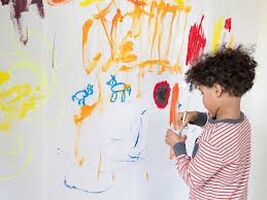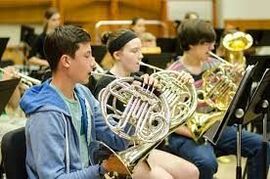Participating in the arts is fundamental to human behavior.

Walk into any daycare center and it won't take long to find a young child shimmying down the hallway, humming an improvised tune, or decisively waving a paintbrush onto an easel paper ("I am making...a lollipop!"). No one needs to ask these youngsters to act in these ways - in fact, it is often impossible to get them to stop.
Visit a high school. Tired adolescents wander in from the bus, ears covered with bubble-shaped headphones - a desperate attempt to use their favorite music to gain some energy and improve their mood. Before class begins, these students use their phones to carefully flip through filters on Snapchat and Instagram, deeply observing the differences in order to post the best possible versions of their amateur photography.
There must be deeply engrained reasons why people of all ages engage in artistic behaviors - the arts are ubiquitous, present in all cultures (Dissanayake, 1988; Winner, 2019). While Youtube, fancy ear buds, and other technological advances make the process of engaging with the arts very easy today, there is nothing new about humans making, consuming, and appreciating the arts. Our earliest ancestors, between hunting for food, finding shelter, and protecting themselves from the dangers of living in the elements, found time to paint on cave walls with ochre (99,000 years ago; Balter, 2009) and to make music from animal bone flutes (30,000 years ago; Conard, Malina, & Munzel, 2009). You can't get a complete look at human behavior without including the arts.
Visit a high school. Tired adolescents wander in from the bus, ears covered with bubble-shaped headphones - a desperate attempt to use their favorite music to gain some energy and improve their mood. Before class begins, these students use their phones to carefully flip through filters on Snapchat and Instagram, deeply observing the differences in order to post the best possible versions of their amateur photography.
There must be deeply engrained reasons why people of all ages engage in artistic behaviors - the arts are ubiquitous, present in all cultures (Dissanayake, 1988; Winner, 2019). While Youtube, fancy ear buds, and other technological advances make the process of engaging with the arts very easy today, there is nothing new about humans making, consuming, and appreciating the arts. Our earliest ancestors, between hunting for food, finding shelter, and protecting themselves from the dangers of living in the elements, found time to paint on cave walls with ochre (99,000 years ago; Balter, 2009) and to make music from animal bone flutes (30,000 years ago; Conard, Malina, & Munzel, 2009). You can't get a complete look at human behavior without including the arts.

But why do we engage in the arts?
What do the arts do for us?
My research agenda
There is much that the arts can do for us -- provide us with alternate ways of understanding, allow us to communicate more fully, connect us with each other, heal emotional traumas, and learn life broad habits of mind. For all we empirically know and anecdotally believe about the arts, there also dozens of claims made about the power of the arts that remain uninvestigated or are based on only correlational evidence. My research critically investigates questions about what the arts do for us within my wheelhouse: schools and other educational environments.
My research centers on two broad questions:
What do we learn through arts education?
What do people think that we learn through arts education?
There's no one way to understand something -
using mixed and multi-methods in my research allows me to illuminate multiple ways of knowing about arts education.
What do we learn through arts education?
What do people think that we learn through arts education?
There's no one way to understand something -
using mixed and multi-methods in my research allows me to illuminate multiple ways of knowing about arts education.